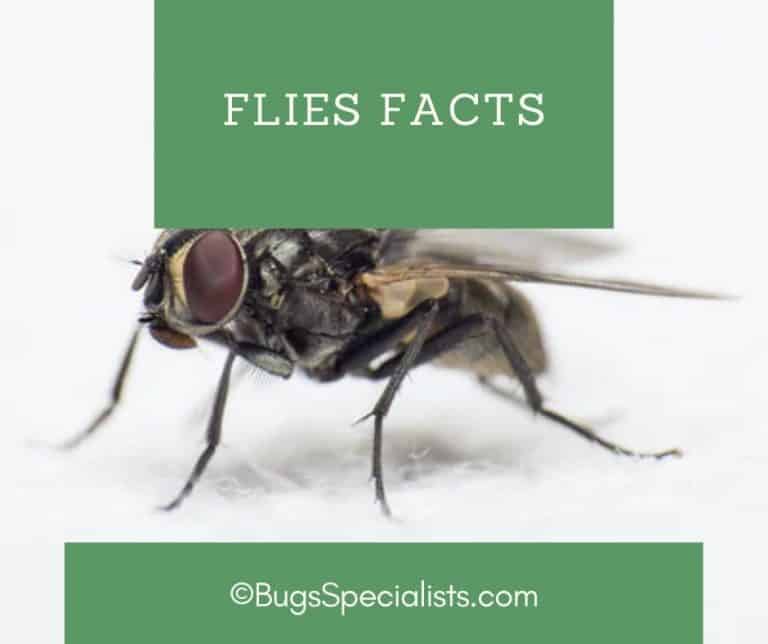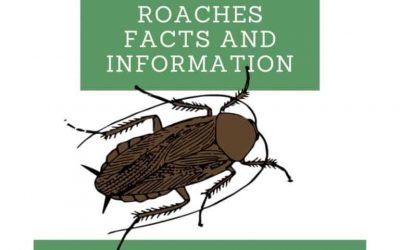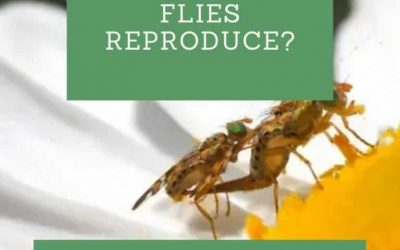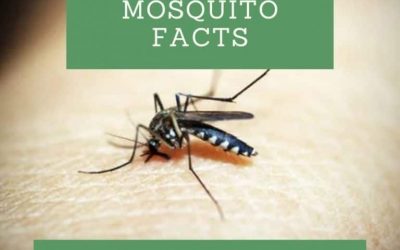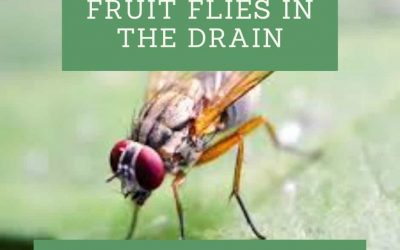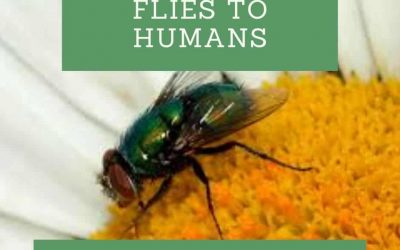Flies can quickly turn your house into a petri dish. They are nauseating and are known to carry horrible viruses, bacteria, and parasite eggs.
The fact that they feed on fecal matter, wound discharge, decaying matter, and sputum makes it even worse. You definitely don’t want these creatures buzzing around your face or settling on your food.
There are over 110,000 species of documented flies all over the world. Some species, such as the housefly, are known to live around humans.
In most cases, you will find them in urban centers, and they tend to thrive in places where there is readily available food, such as hotels, restaurants, and health care centers. Despite their disgusting nature, flies have fascinating facts you’d want to check out.
Flies Facts that will amaze you
1. Flies Don’t Chew
The feeding habit of flies is quite interesting; their digestive mechanism doesn’t allow them to chew. What they do instead is whenever they land on food, flies release certain enzymes that break down the solid food into liquid, after which they consume.
2. Flies have taste receptors on their feet
Imagine tasting your food with your feet before eating. That’s what flies do. They have taste receptors on their feet that help them taste the food before they can eat it. So if you notice a fly lurking around your food, it’s probably checking if that’s going to be a tasty meal.
3. Flies can see behind them
Ever wondered why whenever you try to hit a fly, it moves away quickly as if it was expecting? Well, flies have compound eyes that give them 360 degrees of view. Unlike humans, flies don’t have to turn their bodies nor flicker their eyes, which means they are always on the lookout for danger.
4. House flies poop and vomits a lot
Upon research, scientists found out that houseflies defecate after about every 3-4 minutes throughout the day. You could be sitting outside, and a fly lands right above your nose, and that’s where it leaves its mess.
They never mind where they empty the bowels. When they find the food tasty, they release stomach juices which most people refer to as vomit. Be cautious when flies land on you because they could be carrying diseases in their poop or vomit.
Related Reading How to keep flies off my dog naturally
5. Fruit Flies can survive without heads and wings
Scientists never seize to come up with wonders. It was recently discovered that a fruit fly could live for several days without either the head or wings but not both at the same time. Surprisingly, the male fruit fly will continue to court the female despite being headless. The headless female also continues to live normally and can even fly and walk whenever it feels.
6. Flies spread so many diseases
Most people find flies annoying because of the diseases they spread and their disgusting feeding and breeding habits. They are known to cause over 65 diseases through bacteria, viruses, and parasites. Some common infections known to be spread by these pesky insects include Anthrax, Cholera, Salmonella, Tuberculosis, and Typhoid.
7. Houseflies live for a concise period
Houseflies don’t live for a very long time. The lifespan of an average housefly is about 30 days, and it takes only ten days from the period they hatch to when they become mature adults. With access to sugar and other food materials, houseflies can live for quite a long time.
The warmer the temperature, the longer they are likely to live. However, houseflies cannot make it past 3 days without food.
Read more on : Why are there dead flies in my basement?
Life Cycle of a Housefly
Like most insects, houseflies undergo a complete metamorphosis experiencing all four stages of development. More so, they don’t live for a long time. After about thirty days, the flies are usually dead or on the verge of death.
1. Egg
The cycle begins with an egg, larvae, and then pupae, from which the adult develops. An average housefly can lay up to six batches in her entire life, with each batch containing about 150 eggs.
After 8 hours, the eggs hatch, and within 20 hours, the flies are usually through with the first three stages of larvae development.
2. Larvae
There are four stages in larvae development. The maggots grow so fast, and after each stage, they shade their skin (molt). During this stage, they feed on decomposing waste material such as fecal waste and dead animals.
Maggots are white, legless creatures that move by crawling on their bodies. After they molt for the last time, maggots choose a dark place for the next stage of the life cycle, the pupal stage.
3. Pupa
The pupal stage of development is crucial because this is when the fly develops wings, legs, and other body functions.
You might compare this stage with cocoons in butterflies, only that with flies; they are protected with hard brown cases. It usually takes about three days for a complete pupal stage, but it can go for as long as six days.
4. Adult
The adult stage is the final stage in the life cycle of a housefly. During this stage, the fly is usually fully developed and capable of mating and laying eggs.
The complete process takes about ten days, upon which the housefly can live for another two to three weeks.
Related Reading How to Get Rid of Fruit Flies with Lemon
How do Flies Mate
The complexity behind the mating behavior of flies is outstanding. Just like in most animals, the male fly makes the advances. It quickly strikes the female fly, landing on top of the thorax with its front legs resting at the female’s wings base. The hind legs will then rest underneath the abdomen of the female fly.
At this point, the female wings stretch out and vibrate so rapidly, producing a loud buzz. When the male is set in the proper position, it stretches out its front legs and strokes the female fly’s head. The female may show resistance and shake off the male, especially if it has mated before.
If the male strikes midair, they will both land on a surface nearby. During copulation, the female prods its organ into the genital opening of the male to get sperm. Female flies store the sperm until the ova is ready to get fertilized. That’s why they may show resistance from the male.
Surprisingly, the mating in flies can take up to two hours which is quite a long time since flies are quick creatures. They hatch so fast, grow fast, and move quickly, but their mating takes a weird, long time.
Read more on: where do fruit flies lay eggs?
General Behavior of Flies
The behavior of flies may surprise you, especially if you are not used to having them around. There are over 110,000 species of flies worldwide, and understanding how they behave in different stages of their growth might help fight infestations.
1. Buzzing sound
Flies produce a weird buzzing sound when they move from one place to another or when startled. The buzzing sound is a result of flies beating their wings together. It may be high or low, depending on the species. It’s not a unique thing among flying insects since most of them are known to rub their wings when flying.
2. Rubbing legs
Ever wondered why whenever a fly settles down unstartled, it rubs its legs together? The truth may surprise you because these creatures are actually cleaning up themselves of debris and food particles stuck on their legs. Of course, flies are known to be the filthy creatures that crawl on animal poop and feed on sputum and dead decaying animals. Shockingly, they clean up after every meal.
3. The behavior of flies when eating
Flies have two sponge pads and a straw that helps them suck up liquefied food. Naturally, they can’t chew, so they have to dissolve their food into liquid or tiny particles before they can swallow. They dissolve the food by releasing an enzyme from their stomach, which liquefies the food or breaks it down into small finer particles.
When flies crawl from one end of your plate to the other, they constantly taste your food with their feet. If they find the meal tasty, they release an enzyme from their stomach to liquefy the food before eating. Most people refer to the stomach enzyme as vomit and can also carry pathogens that transmit diseases.
Related readingHow to get rid of fruit flies with hydrogen peroxide
Disgusting Facts about Flies
They may be tiny and portray that harmless look, but flies are very vile creatures. Often you will find them a nuisance because of their constant buzzing. These are insects you don’t want around your business, especially if you are in the hospitality industry or a health care professional. They carry pathogenic microorganisms known to cause such severe illnesses in people and other animals.
1. They survive on filth
At no point will you ever find a fly breeding in a clean environment. It is always a place where there is filth, such as animal carcasses, fecal matter, waste dump, and wounds. Often you will find them in toilets, pit latrines, and kitchens. You don’t want a fly crawling all over your food because you never know where it stopped last for a meal.
2. Flies taste food with their feet
So much can be said about flies, but the fact that they taste with their feet is even more astonishing. Flies have taste receptors located on their legs. When they creep on feces and dead decaying matter, they are practically tasting the food to see if it will be a sumptuous meal. You may never mind this fact, but reality will dawn on you when the fly lands on your food and starts doing the same thing.
3. Flies can poop and vomit anywhere
There is a saying that goes, never poop where you eat. Tell that to a fly, and it will shag you off. Because flies survive on a liquid diet, their digestion tends to move quite fast for them. Research has shown that after every 2-3 minutes, flies defecate. Whenever they land on food and find it tasteful, they vomit some stomach enzymes to liquefy the meal.
You could be seated outside on your porch having some grilled meat, and all of a sudden, a fly lands right on top of your steak just before you take a bite.
Disgusting, right? But you ignore it because you really anticipated the edge, so you take it anyway. You fail to understand that the fly could be carrying some pathogenic microorganisms that could make you very sick.
Related reading What to pour down drain for fruit flies?
4. Maggot Infestations
Margot infestations happen when flies lay eggs on living organisms upon which they hatch into larvae or maggots. The maggots feed and develop on the subcutaneous layer of the living organism.
Infestations happen mostly when you have a wound or live in squalid conditions or areas known to harbor maggot infestations. Some flies are known to start infestation even on unbroken skin, but it rarely happens.
5. Flies Carry Disease-Causing Pathogens
Flies are the last thing you’d want to invade your space. Scientists have realized that some flies, such as the common housefly, can carry more than 1 million bacteria with the potential of contaminating food and working surfaces.
Some are known to transmit viruses and parasite eggs to a host, and in most cases, it is usually human beings. These pathogens are hazardous, and some may be fatal if not treated.
Read more on: What diseases do horseflies carry?
Frequently asked questions on fact flies
Which Country Has no Flies?
With over 110,000 species available worldwide and the speedy rate at which they multiply, you should expect to find flies everywhere on this planet.
But that’s not so because there are some conditions that flies cannot survive, and even if they do, they won’t be for a long time. For a long time, there has been no insect reported on Iceland, and that includes flies.
The temperatures are usually too low that the insects freeze to death even if they took a ride with humans from warmer places. You may see a few insects in Iceland, but they are not native to the Country; however, be sure that they won’t be surviving for a long time.
Another place that has reported no insects is the Canary Islands, situated off the Moroccan coast. Initially, there were no humans in this place, but the recent human invasion brought some insects, including flies.
These insects are survivors, and often you will find them in places you least expected. Iceland seems to be the only place where flies are not available, mainly because of the freezing temperatures, making it hard for the insects to function.
Related reading Why Do Horse Flies Bite?
What do Flies Eat on Your Skin?
As we happen to know, the regular fly diet is nothing short of disgusting. So when a fly lands on your skin, there is certainly something that it was attracted to. Humans tend to secrete body fluids such as sweat, tears, and even blood when injured. Infected wounds release pus which is also known to attract flies.
Flies are often attracted to fluids and scents released from the body. Sweat, tears, pus, and blood contain minerals and food compounds that flies find attractive. They see your skin as a source of proteins, salts, sugars, and even carbohydrates. The human skin smells like or produces at least one of these body fluids at some point.
Surprisingly, it is relatively impossible for flies to miss you because they depend on smell, even if it brings to mind a tiny bit of what they are looking for. They won’t waste a single minute to prey on your skin for whatever little they find.
Some flies, such as the horsefly, are pretty aggressive and might even poke your skin and drink up the blood piles in the wound. Therefore, you have to wear long-sleeved shirts and long pants whenever you are out on a hot day, especially in areas prone to these insects.
In the fly world, they are just looking for food and don’t mean us any harm. But the pathogenic microorganisms they carry is nothing to smile about.
What do Flies Eat?
Flies have so many food sources, and the preference for a certain type of food can vary from one species to another. Typically flies feed on anything from human food, plant nectar, to fecal matter. Often you will find them around carcasses of dead animals where they also lay their eggs.
Flies rely on a liquid diet because they have sponging mouths that aren’t built to chew. Whenever they land on solid food, they vomit a particular enzyme from their stomachs which liquefies the food. They have sensory organs on their legs that taste the food before they can eat.
Contrary to popular belief, fruit flies don’t feed on fruits. Instead, they are more attracted to the yeast produced from the ripening fruits. You may see them lurking around fermenting substances or spilled alcoholic beverages. Sugar seems to be a thing for them, and every so often, you will find them feasting on ripe bananas.
House flies prefer decaying food material; that’s why you will find them in kitchen waste bins. They also feed on human and animal fecal matter in search of sugars, proteins, carbohydrates, and other minerals. Basically, they thrive where there is filth and decaying matter.
Related reading How to keep flies away from plants
Do Flies Sleep?
During the day, you get bugged by flies buzzing around your ears. They literally don’t give you peace of mind. But have you ever thought of where they go at night? Do these insects ever sleep? If you believe they do sleep at night, well, your thought is as good as mine. Most of the flies sleep at night, but they also take short naps during the day.
Flies are least active during the night because of the cold temperatures, making their bodies slow down and not function properly. Most flies take refuge under grass, leaves, branches, corners, and under furniture during the night.
Flies have a central nervous system which is an essential part of enabling them to sleep. They also have a sleeping pattern, just like humans do. For instance, humans sleep in two stages, commonly known as light and deep sleep. Research has shown that flies also have the same sleeping patterns where they alternate between light and deep sleep.
Younger flies tend to sleep for longer hours than older flies because their brains need to develop. Sleep is also affected by the intake of drugs and chemicals.
For instance, caffeine keeps them awake, while alcoholic beverages make them drowsy. Flies can sleep for up to 12 hours during the night and are more active when the weather is warmer.
How to get rid of non-biting midges
Do Flies Have Brains?
Yes. This reality may shock you because flies are relatively tiny insects. However, you can’t compare their brain functionality with that of humans.
In fact, flies can live without the brain for a few days as long as they don’t lose the hemolymph. The brain is located in the head and consists of three lobes, each controlling different functionalities.
Related reading How to get rid of flies with white vinegar
Do Flies Have a Heart?
Humans like comparing how their bodies function with that of other living organisms. Flies do have hearts, but they don’t resemble the human heart in any way. The fly’s heart is simply a long tube that stretches along its abdomen. They have an open circulatory system that expands and contracts to circulate the blood (Hemolymph) through the entire body.
The fly heart doesn’t have arteries and veins, so it’s practically impossible for them to even have a heart attack. However, for the supply of hemolymph to organs such as wings and legs, the flies have accessory channels in the thorax that directs the hemolymph using heart rhythms. The blood is pulsated from the abdomen and led straight to the head of the fly.
Do Flies Have Lungs?
Even if you could find a tiny rope to tie around the neck of the fly, at no point will it choke to death. They don’t have a sophisticated place where they gather oxygen to be absorbed and be transported throughout the body. Flies don’t have lungs; instead, they breathe through tiny openings on their bodies called spiracles.
Spiracles are part of tubes that connect to the tracheal, which is filled with fluids. The tube is called the trachea, and it directs the oxygen t o the tracheal, which then diffuses with the fluids. The oxygen diffuses through the walls of the tracheal to the insect’s body cells.
Related reading Are green bottle flies dangerous?
Do Flies Have Ears?
The human ear and the fly ear are two very distinct organs, just as humans are different from the fly. However, they both have mechanisms that help them amplify low sounds. It would be correct to say that flies don’t really have ears but instead use their antennae to interpret sounds.
The outer segments of the antennae act as the receivers. In humans, this part is called the eardrum, and it’s responsible for receiving sound waves. Yes, flies have ears, but the organ is not as sophisticated as a human being or any other mammal with a comprehensive hearing organ.
Do Flies Feel Pain?
For over 15 years now, it’s been evident that insects, particularly fruit flies, feel something that can be compared to acute pain. Scientists refer to this feeling as nociception. Recently they also discovered that the nervous system of the fly can also experience chronic pain. The difference between chronic pain and acute pain is that chronic pain can last for as long as the fly lives, while acute pain is short-lived.
To understand if insects also experience chronic pain, scientists amputated several fruit flies’ legs and kept them with other flies. Such an injury is known to cause chronic nerve pain even to human beings. After the wounds healed, they were placed in rooms with temperatures to monitor if they responded to stimuli.
The scientists discovered that once the temperatures were brought down, the injured flies tried to escape the room because they could no longer withstand the hot temperatures. They responded to stimuli which means that they felt some level of chronic pain. Yes, flies and probably other insects, too, can feel pain.
Related reading Why are there so many flies in my house
Fly Facts for Kids
If you plan to get deep into the study of flies, then good for you because they are among the most studied insects globally, and there are tonnes of information about them to feed your brain. Some of the many facts about these insects include:
- A female fly can lay over 9000 eggs in her entire life, with each batch containing between 75-150 eggs.
- The eggs hatch within a day, developing into maggots that feed on the host, whether it is a dead animal’s carcass or fecal matter.
- Flies have sensory organs on their feet to determine if a meal will be a sumptuous one.
- Flies live on a liquid diet which makes them poop after about every 2-3 minutes because food moves through their digestive system quite fast.
- Most fly species don’t live for a long time. In about 30 days, the fly is usually dead or on the verge of death.
- Flies can view behind them with their 360 degrees enabled compound eyes. That explains why it is usually so difficult to swat a fly.
- Flies vomit before they eat to liquefy the solid food with stomach enzymes.
Related reading How to hang bags of water to repel flies
Fun Facts about Flies
There is so much information about flies you may never exhaust in a single sitting. But some of the fun facts about these creatures can help you understand them much better.
- Flies don’t have ears; instead, they use their antennae to amplify low sounds, which are then interpreted by the brain.
- Flies have more than two eyes. Apart from the compound eyes, another pair of eyes help them interpret light changes and different brightness levels.
- Male flies are always on the lookout for mating partners, and the females may resist their attempts, especially if they have mated before.
- When the male fly strikes in an attempt to mate with the female, the attack can happen anywhere, even midair, before they finally land flat on their thorax.
- Flies are known to clean after every meal, something that you should also copy. When you see them rubbing their front legs together, they are getting rid of food debris and dust.
- Flies are always flight-ready in that they can take off any time when startled.
Related reading What Purpose Do Flies Serve?
Types of Flies
Over 110,000 species of flies globally and over 17,000 of these species are found in North America alone. Identifying the kind of fly you are dealing with is essential, especially if you are dealing with an infestation. Some flies might look somewhat the same, but what sets them apart is their behavior and, to some extent, their physical appearance.
Some of the most common flies include the housefly and the fruit fly.
Housefly
Time and again, you will see this fly around your home. They are widely spread throughout the world and are known for their distinct gray color and four white stripes along their thorax.
Houseflies have red compound eyes. They grow pretty fast and may take as little as seven days to develop from an egg to an adult.
Fruit fly
Like houseflies, fruit flies are also found globally, and once in a while, you may spot them in your house. They appear to be brown and may have red or darker eyes with a gray and black abdomen.
Often you will see them lurking around decaying food matter, fruits, and alcoholic beverages. In ideal conditions, the fruit fly can lay up to 500 eggs which can hatch within a day and develop into an adult within a week. They can live for up to 30 days.
Related reading Why Are Flies Attracted to Me?
Horsefly
Some people may get chills even by the mention of a horsefly. Every so often, you will find them around horses which explains their name. They have enormous green or purple eyes with short antennae.
They fly fast and are even known to attack moving objects. The female horsefly mainly feeds or blood while the male survives primarily on pollen. Female horseflies can also attack humans and other animals. They are vectors of diseases, especially pathogenic bacteria.
Some other types of flies include:
- Blowfly
- Black fly
- Flesh fly
- Pollenia Rudis
- Calliphora
- Common green bottle fly
- Crane-fly
- Stable fly
- Deerlfies
Related reading How to get rid of corn flies
How to Identify Flies
Like most insects, a fly has three body parts: the head, thorax, and abdomen. Different species have different physical characteristics, but the head has two compound eyes and a pair of antennae for most of them.
The thorax has a couple of wings that help the fly move around and six legs with three on each side. The color of the flies varies from one to another; however, you may see gray, green, brown, tan, and even black.
Related readingHow to Stop Nesting Flies Nesting in Window Frames
Bottom Line
A fly infestation is the last thing you want to deal with, whether at home, your restaurant business, or your health care center. They are known to carry pathogenic microorganisms that cause very severe illnesses. Flies feed on filth such as decaying food, animal and human fecal waste, rotting fruits, and even alcohol.
They also vomit and poop a lot which means that you need to be always cautious because you can quickly get plague-ridden with diseases.

